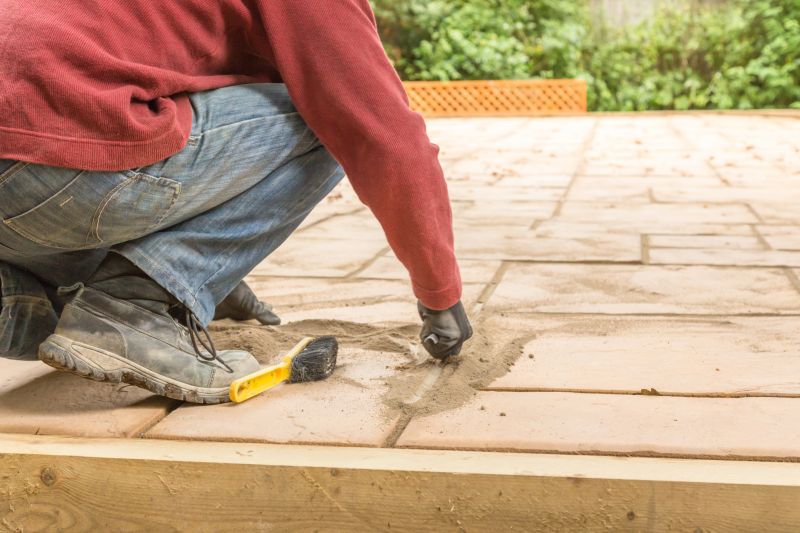Ultimate Guide To Paving Stone Repair Products For Seamless Results
Find out which repair products deliver optimal performance to restore and enhance your paving surfaces effectively.
 Paving stone repairs are essential for maintaining the safety, functionality, and aesthetic appeal of outdoor surfaces such as patios, walkways, and driveways. When paving stones become loose, cracked, or uneven, addressing these issues promptly can prevent further damage and costly replacements. Repair products are designed to help homeowners and professionals restore the integrity of paved areas efficiently and effectively. From simple patching compounds to advanced joint stabilization systems, there are numerous options tailored to different repair needs.
Paving stone repairs are essential for maintaining the safety, functionality, and aesthetic appeal of outdoor surfaces such as patios, walkways, and driveways. When paving stones become loose, cracked, or uneven, addressing these issues promptly can prevent further damage and costly replacements. Repair products are designed to help homeowners and professionals restore the integrity of paved areas efficiently and effectively. From simple patching compounds to advanced joint stabilization systems, there are numerous options tailored to different repair needs.
Top Overall Option
Polymer-Modified Paving Stone Repair Compound
This versatile repair compound is designed to bond effectively with existing paving stones, providing a durable and flexible fix for cracks, chips, and loose stones. Its polymer-enhanced formulation allows for easy application and fast curing, making it suitable for both minor and moderate repairs. The compound adheres well to various paving materials and resists cracking over time, helping to restore the surface's integrity. Its smooth consistency facilitates seamless filling, ensuring a neat appearance after finishing.
Types of Products For Paving Stone Repairs
Polymer-Modified Repair Compounds
Flexible, durable compounds for filling cracks and bonding loose stones.
Paving Stone Adhesives
Strong bonding agents for reattaching loose or broken stones securely.
Joint Sand and Filler
Materials used to fill gaps between stones and stabilize the surface.
Polyurethane Sealants
Sealing products that prevent water infiltration and protect repairs.
Concrete Patch Mixes
Ready-mixed or powder-based patches for filling larger cracks or holes.
Leveling Sand
Fine sand used to level uneven surfaces before laying or repairing stones.
Polymer Resins
Resins that provide structural reinforcement for cracked or broken stones.
Epoxy Repair Kits
Complete kits containing adhesives and fillers for comprehensive repairs.
Surface Sealers
Protective coatings that enhance durability and appearance of repaired areas.
Crack Repair Tubes
Pre-packaged tubes for quick filling of narrow cracks.
Mortar Mixes
Traditional repair materials for joint and stone bonding.
Polymer Grouts
Flexible grout options for filling joints and stabilizing stones.
Bonding Agents
Primers and adhesives that improve the adhesion of repair materials.
Self-Leveling Compounds
Materials that help create a flat, even surface for repairs.
Waterproofing Sealants
Products that prevent water penetration and protect repairs from weathering.
Popular Choices
Widely used for their flexibility and ease of application in various repairs.
Commonly selected for reattaching loose stones securely.
Popular for filling gaps and stabilizing paved surfaces.
Favored for sealing repairs and preventing water ingress.
Frequently chosen for filling larger cracks and holes.
Often used to prepare surfaces before laying stones.
Popular for comprehensive repairs requiring strong bonding.
Commonly applied to prolong repair longevity and enhance appearance.
Convenient for small, quick fixes on narrow cracks.
Chosen for their flexibility in joint filling applications.
Used to improve adhesion between repair materials and existing stones.
Preferred for creating smooth, flat repair surfaces.
Selecting the right repair products depends on the specific condition of the paving stones, the type of damage, and the desired longevity of the repair. Some products are formulated for quick fixes, offering ease of application for minor cracks or loose stones, while others are engineered for more substantial repairs requiring durable bonding and stabilization. Proper preparation, including cleaning and leveling the surface, enhances the effectiveness of repair materials and ensures a more seamless result.
In addition to repair compounds and adhesives, there are specialized tools and accessories that facilitate the repair process. These include joint fillers, sealants, and leveling sand, which help to secure stones in place and prevent future shifting. When choosing repair products, it is important to consider compatibility with existing paving materials, ease of use, drying or curing times, and the overall durability of the repair. Investing in quality repair products can extend the lifespan of paved surfaces and maintain their visual appeal over time.
Whether addressing minor cracks or more significant structural issues, understanding the range of available products can help you make informed decisions. Proper application and maintenance are key to achieving long-lasting results. Consulting product labels and instructions ensures that you select the right materials for your specific repair needs, ultimately helping to preserve the integrity and appearance of your paved areas.
Key Buying Considerations
- Compatibility with existing paving materials to ensure proper adhesion.
- Type and extent of damage to determine the most suitable repair product.
- Ease of application based on your skill level and available tools.
- Drying or curing times to fit your repair schedule.
- Durability and weather resistance for long-lasting repairs.
- Flexibility of the repair material to accommodate slight ground movements.
- Color matching options for aesthetic consistency, if applicable.
- Water resistance to prevent future damage from moisture infiltration.
- Cost and value for money considering the repair scope.
- Availability of complete repair kits versus individual components.
- Surface preparation requirements for optimal results.
- Environmental conditions during application, such as temperature and humidity.
- Potential need for sealing or finishing products post-repair.
- Brand reputation and product reviews for reliability.
- Storage and shelf life of repair materials.
